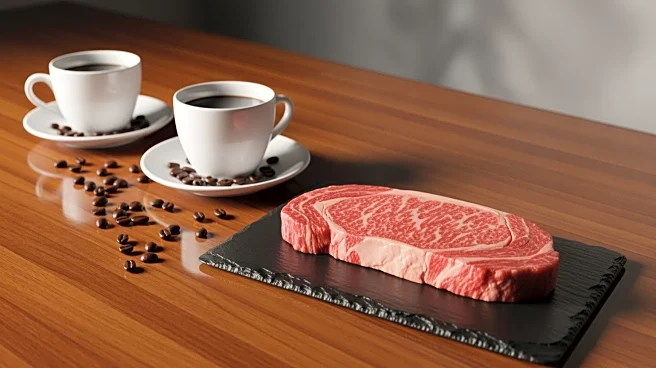What's Happening?
Coffee enthusiasts often aspire to make the perfect espresso shot at home, a task that can be challenging without the right technique and equipment. Kaleena Teoh, co-founder of Coffee Project New York,
provides insights into mastering espresso brewing at home. Espresso is a precise brewing method that involves pushing hot water through a compacted puck of coffee, requiring specific pressure and temperature calibration. Teoh emphasizes the importance of grind size, recommending a fine sand-like texture for the coffee beans. She also highlights the significance of a good burr grinder over high-end espresso machines, as the grind size greatly affects the shot's quality. Additionally, Teoh advises on the coffee-to-water ratio, suggesting a range between 1 to 1.5 and 1 to 2.5 for optimal strength. Proper puck preparation, including leveling and tamping, is crucial to avoid uneven extraction. While crema, the foam layer on top of espresso, is desirable, it does not significantly impact flavor but contributes to mouthfeel.
Why It's Important?
The ability to brew quality espresso at home can enhance the coffee experience for many enthusiasts, offering a more personalized and cost-effective alternative to frequenting coffee shops. Understanding the nuances of espresso preparation, such as grind size and coffee-to-water ratio, allows individuals to tailor their brews to personal taste preferences. This knowledge empowers consumers to make informed decisions about coffee equipment investments, prioritizing grinders over expensive machines. Additionally, mastering espresso techniques can lead to a deeper appreciation for coffee as a craft, potentially influencing consumer behavior and preferences in the coffee market. As more people seek to replicate café-quality beverages at home, there may be increased demand for high-quality coffee beans and grinders, impacting coffee industry trends.
What's Next?
As home brewing techniques become more accessible, coffee enthusiasts may continue to experiment with different beans, roasts, and equipment to perfect their espresso shots. This could lead to a rise in consumer interest in specialty coffee products and educational resources. Coffee equipment manufacturers might respond by developing more affordable and user-friendly grinders and machines tailored to home use. Additionally, coffee shops may see a shift in consumer behavior, with patrons seeking unique experiences or specialty drinks that are difficult to replicate at home. The growing trend of home brewing could also inspire coffee-related workshops and community events, fostering a culture of shared knowledge and appreciation for coffee craftsmanship.
Beyond the Headlines
The pursuit of perfect espresso at home reflects broader cultural trends towards DIY and artisanal practices, where individuals seek to master skills traditionally reserved for professionals. This shift may influence consumer expectations, with a growing emphasis on quality and authenticity in food and beverage experiences. As people become more knowledgeable about coffee, there may be increased scrutiny on sourcing practices and sustainability within the coffee industry. Ethical considerations, such as fair trade and environmentally friendly production methods, could become more prominent in consumer purchasing decisions. The emphasis on home brewing also highlights the evolving role of technology in everyday life, as individuals leverage tools and resources to enhance personal experiences.














